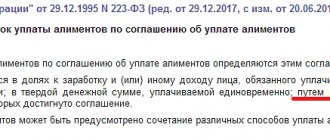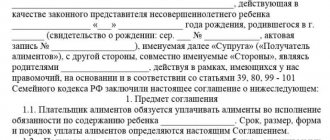The main task of the bailiff service is to fulfill the requirements specified in the executive documents. Such documents include:
- A writ of execution issued by courts in response to decisions.
- Orders of magistrates.
- Alimony agreements.
As a rule, bailiffs are only limited to the role of observers when the alimony person fulfills his obligations in good faith and in a timely manner. However, non-payment of alimony and the appearance of a debt on it allows the bailiffs, of their own free will or on the initiative of the claimant, to actively intervene in the process and use the methods specified in the law in order to change the illegal behavior of the alimony defaulter.
An effective way of legal influence on a debtor is to seize property for non-payment of alimony, i.e. restriction of the rights of the defaulter to use or dispose of personal property assets. In other words, the bailiff actually seizes the seized property and prohibits its alienation to third parties. The bailiff can seize any liquid property, which usually means:
- Commercial real estate and housing (houses for individual residence, apartments).
- Vehicles (motorcycles, boats, cars, trucks, other self-propelled vehicles).
- Luxury items (antiques, art, expensive clothing).
- Bank accounts, such as debit cards; current accounts; borrower's credit limits on credit cards; salary cards issued by the employer.
- Jewelry.
- Rights of claim against third parties (accounts receivable).
- Bonds and shares of companies and enterprises.
If the seizure of liquid property does not change the behavior of the defaulter and does not force him to cover the alimony debt, then at the next stage more severe consequences may occur for the alimony payer, for example, the sale of his property through auctions or auctions, as well as the imposition of administrative or even criminal punishment.
The following will describe in what cases bailiffs seize liquid assets, how they do this, as well as how alimony payers can challenge their illegal decisions. Keep in mind that it is only possible to guarantee and 100% avoid seizure of your own property if alimony is paid on time and in full.
Legal consequences of evading payment of alimony
They occur only if the defaulter knowingly and intentionally, i.e. through his own fault, avoids paying alimony, and the alimony obligation arose on the basis of a court decision or alimony agreement. According to Russian law, there is no guilt if the alimony payer did not fulfill his obligations for the following reasons:
- He became seriously ill, and therefore could not work or earn money for alimony. The fact of the disease must be confirmed by medical documents.
- He was drafted into the Armed Forces.
- I was on a business trip in a remote area.
- Got into a natural or man-made disaster zone.
- A state of emergency or martial law was declared in the country.
- During the transfer of money to the alimony recipient, there was an equipment failure and a power outage.
- The accounting department did not transfer the money to the alimony recipient on time.
- Has other dependents to support, and the amount of earnings does not allow him to meet the needs of all alimony recipients.
We can distinguish 4 groups of negative consequences for alimony payers who do not fulfill their obligations properly:
- Property.
- Restrictions imposed by bailiffs.
- Administrative.
- Criminal.
Property
These consequences vary depending on the basis on which alimony was collected: by agreement or by court. In addition, bailiffs are obliged to find out the motives of behavior that guided the defaulter in order to determine the degree of his guilt.
| Basis for alimony payments | Consequences of non-payment |
| Judgment |
|
| Agreement |
|
Restrictions imposed by bailiffs
Their list with explanations is given in the table below.
| Restrictions | Legal comment |
| Prohibition on using a driver's license | This prohibition limits the rights to drive any vehicles and is valid until the debt is fully repaid or other circumstances arise at the discretion of the bailiff or collector. The ban cannot be applied in the following cases:
|
| Ban on crossing the Russian border | This measure is applied when the alimony debt grows to an amount exceeding 10,000 rubles, and can be withdrawn only when the debt is repaid in full. |
| Property search | If the measures taken by the bailiff to search for the property assets (money, real estate, jewelry, etc.) of the alimony defaulter were unsuccessful, this does not mean that the alimony payer successfully avoided liability. Regardless of the size of the alimony debt, the bailiff, at his own request or at the request of the alimony recipient, has the right to begin searching for the liquid property assets of the debtor. In order to start a search legally, the bailiff issues a search order. The actions that can be carried out by the bailiff during the search are described below:
|
Administrative
Undesirable consequences for the alimony may occur if he does not pay alimony intended for disabled parents or minor children for more than 2 months from the start of enforcement proceedings and through his own fault. The process begins at the initiative of the bailiff or on the basis of an application from the alimony recipient, a sample of which can be downloaded here.
Next, the bailiff examines the circumstances of the case and the facts available to him and draws up a protocol, which, together with other evidence, for example, a resolution on the calculation of the debt, is sent to the magistrate for trial. The magistrate gives a final assessment of the actions of the debtor on the basis of the materials transferred by the bailiff and assigns the alimony payer one of the following penalties:
- Up to 150 hours of mandatory work.
- 10-15 days of administrative arrest.
- 20,000 rub. fine It should be noted that this type of punishment is applied only to firefighters, police officers, investigators from the Investigative Committee, customs officers, employees of the Russian Guard, military personnel, and disabled people.
Criminal
Consequences in the form of criminal prosecution may arise if:
- The alimony holder did not fully fulfill the administrative punishment imposed on him and, at the same time, again did not pay alimony intended for his disabled parents or minor children, through his own fault for more than 2 months.
- The alimony worker, within 1 year after he had fully executed the administrative punishment, again committed an administrative offense consisting of deliberate failure to pay alimony for more than 2 months.
How is a violator held criminally liable? According to the sequence of actions described below:
- The bailiff conducting enforcement proceedings against the alimony recipient, on his personal initiative or at the request of the alimony recipient, transfers the evidence in his possession (administrative case materials, calculation of debt) to the investigating officer for inspection.
- If there are legal grounds, i.e. repeated administrative offense, the investigating officer initiates a criminal case.
- An investigation is conducted against the accused within 1 month. Its results are documented in an indictment.
- Then the investigator sends the case materials to the prosecutor for study.
- The indictment with a positive conclusion from the prosecutor is handed over to the magistrate for sentencing.
According to the Criminal Code, the guilty person may be sentenced to one of the following penalties:
- Up to 1 year of forced labor.
- Up to 1 year of correctional labor. This is the most commonly used type of punishment.
- Up to 1 year of imprisonment. This punishment is applied to the worst debtors.
- Up to 3 months of arrest.
What cannot be arrested
However, there is property that cannot be seized and included in the bankruptcy estate, regardless of the nature and size of the debt. The list of this property is determined by Art. 446 Code of Civil Procedure of the Russian Federation:
- the only housing
- the land on which it is located
- household items (furniture, refrigerator, washing machine and others)
- things intended for personal use
- products
- animals, if their maintenance is not related to profit-making or business activities
- items, including means of transportation, necessary for the debtor due to disability
- items used for professional activities (for example, musical instruments), provided that their cost does not exceed 10 thousand rubles.
Be careful!
Of course, exceptions to some points are possible. For example, housing and land can be seized if they are encumbered with a mortgage. Items intended for individual use are also confiscated in the case of luxury goods. These include jewelry with precious or semi-precious stones, items made from natural valuable fur, antique items and others.
Procedure for calculating alimony debt
The bailiff can calculate how much the alimony payer owes in favor of the alimony recipient if all the conditions listed below are simultaneously met:
- The recipient of alimony has previously brought to the bailiff's department an agreement on alimony or a writ of execution for a court decision, according to which alimony is being collected.
- The debt arose after the initiation of enforcement proceedings.
- If it is established that the alimony provider is guilty of non-payment of alimony, then the debt is calculated for the entire period when alimony was not paid. If the guilt of the alimony provider is not established, then the debt is calculated only for the previous 3-year period.
The calculation can be made only in 2 cases:
- The alimony recipient demanded to calculate the debt by submitting a corresponding application to the bailiff department.
- The bailiff took the initiative on his own.
How is debt calculated? As a basis for calculations, the bailiff takes the amount of alimony maintenance specified in the alimony agreement or in the court decision. The amount of alimony can be set either as a fixed amount or as a share of earnings.
In the case of a fixed amount, the calculation is very simple. For example, the payer needs to transfer 12,000 rubles monthly to the alimony recipient. The period of time during which there were no payments was 2 months. From this we conclude that the amount of debt is 12,000 rubles. x 2 months = 24,000 rub.
In the case of a share of earnings, the situation is a little more complicated. The calculation principles applicable here are described in the table below.
| Earnings of alimony payer | Legal comment |
| Official (“white salary”) | For example, the judge ordered the child support provider to pay 25% of the money earned for the maintenance of one child. The official income of the payer is 60,000 rubles. The period of time during which there were no alimony payments was 2 months. We calculate the debt: the debtor is obliged to pay 60,000 rubles monthly. x 25% = 15,000 rub. Therefore, the debt is 15,000 rubles. x 2 months = 30,000 rub. |
| Unconfirmed or missing | The calculation is based on the average salary in Russia on the day the debt is determined. In 2021 it is 35,843 rubles. For example, the judge ordered the child support provider to pay 25% of the money earned for the maintenance of one child. The alimony payer does not officially work. The period of time during which there were no alimony payments was 2 months. We calculate the debt: the debtor is obliged to pay 35,843 rubles monthly. (average salary) x 25% = 8,960.75 rubles. Therefore, the debt is RUB 8,960.75. x 2 months = 17,921.50 rub. |
The simplest situations were discussed above. However, the recipient of alimony may also be interested in collecting a penalty from the debtor. In this case, it is advisable to use specialized calculators for calculations, for example, by following this link.
The bailiff formalizes the result of the calculations in a decree and sends it to both the debtor and the recipient of alimony. If a check of the bailiff’s calculations shows that he made a mistake or calculated an amount to be paid that clearly does not correspond to the period of delay, you should contact the district court with a complaint about the unlawful actions of the bailiff.
Exception from the inventory
The next option to avoid seizure is exclusion from the inventory. This right is granted by Part 1 of Art. 119 Federal Law No. 229, it belongs only to the owner of a specific thing and is determined in court.
To do this, the owner of the thing will need to write a statement to the court. Collect documents, witness statements, and other evidence that allows you to establish reliably that the things belong to him and not to the debtor. According to the rules of Art. 56 of the Code of Civil Procedure, the burden of proof lies with the plaintiff.
Please note that in accordance with the Resolution of the Plenum of the Supreme Court and the Plenum of the Supreme Arbitration Court No. 10/22 of 04/29/2010, the defendants in this case will be the debtor and the collector, and not the bailiffs, and they should be invited to consider the controversial issue (clause 51). But the bailiff is invited as a third party.
Often the situation arises due to the fact that it is impossible to allocate shares in the common property of the spouses, so a seizure is imposed on everything that belongs to them. But this is incorrect, since in accordance with Art. 256 Civil Code and Art. 45 SK debts can be collected only from that part of the property that belongs to the debtor.
And if the spouses have only joint property, then the bailiff must first petition the court to allocate his share and only after that impose a penalty on only half of it. In this case, the second spouse will need to challenge the bailiff’s decision and ask to exclude his property from the inventory.
Grounds for seizing the property of an alimony debtor
So, there is a debt for alimony of at least 3,000 rubles, the debt has been calculated and formalized by the bailiff, and it has also been established that it is the alimony provider who is to blame for the debt. The guilt consists of deliberate evasion of payment of alimony; concealing information about the availability of additional income; concealing information about a new place of work; the presence of a criminal or administrative conviction for non-payment of alimony from the defaulter. This is quite enough to seize the liquid property of the alimony provider.
The procedure for imposing and removing seizure of property
Seizure
If there are grounds for arrest, the bailiff, at the request of the alimony recipient or on his own initiative, decides to seize the property assets of the defaulter. The purpose of this action is to ensure the safety of the defaulter’s assets and prevent their deliberate alienation to third parties.
The bailiff is obliged to respond to the application of the alimony recipient very quickly, namely: a decision on the application must be made no later than the next day after the application is accepted. However, the following fact must be taken into account: the bailiff does not have the right to seize the pledged property assets, since the pledge holder has an advantage in collection over the alimony recipient.
The procedure for seizing various categories of property assets is described in the table below.
| Property category | Actions of the bailiff |
| Registered objects (apartments, cars, land plots) | The bailiff issues a decree of arrest and sends an electronic copy of it to the traffic police (if the defaulter has a car) and to Rosreestr (if the alimony holder has real estate) within 3 days. |
| Precious metals and money stored in banking institutions | The bailiff prepares the arrest order in paper form and sends copies of it to banks that are reliably known to have accounts for the alimony payer. If there is no information about the alimony provider’s accounts, but the bailiff has reasonable suspicions about their existence, a resolution to search for the accounts is drawn up and sent to all banks and the tax office. In turn, the bank, immediately after receiving the arrest order, freezes the alimony payer’s money within the amount of the arrest and informs the bailiff about this. If there is not enough money in the accounts, then the bank is obliged to stop all operations on them, except for replenishment operations, and continue to execute the arrest order until the bailiff cancels the arrest. Keep in mind that the bank cannot withdraw money from the seized account to pay off the monthly loan payment or to pay the account maintenance fee. |
| Other property | The arrest is made by a bailiff on the basis of an act of seizure with an inventory of seized property assets included in it and always with the participation of at least 2 witnesses. A sample seizure report can be viewed here. The act contains the following information:
|
The alimony defaulter should keep in mind that the bailiff has the right to seize, among other things, the only housing that is suitable for living and is in his property. The land on which the only residence is located may also be subject to seizure.
This is not a violation of the law, since according to the position of the Supreme Court, arrest in this case is appropriate. Its purpose is to prevent the defaulter from selling the home and, thereby, to protect funds from collection. At the same time, the Supreme Court indicated that the arrest should not create obstacles for the alimony provider in the use of housing.
Removal of arrest
There are several options for action that allow the alimony payer to lift the seizure of his property. Let's take a closer look at them.
First option. If the bailiff calculated the amount of the debt correctly, and the alimony provider has no grounds to challenge his calculation or seizure, then the best solution would be to cover the existing debt. To do this, you need to go to the bailiff who imposed the arrest and get from him the details of the deposit account of the bailiffs department. In any bank, money should be transferred to this account in an amount equivalent to the amount of debt. After this, bring the check to the bailiff and demand that the arrest be lifted immediately.
Second option. It is suitable for cases when the debt is below 30,000 rubles, but there is no money to pay it off.
Within 10 days counted from the moment the bailiff draws up a decree on the assessment of the seized property or an act of arrest, if the assessment is not disputed by the alimony payer, you need to agree with a relative or friend that he (she) will lend money and fictitiously buy back the seized item. Next, you need to go to the bailiff who carried out the arrest and petition him to independently sell the seized item.
After this, the bailiff makes a decision according to which the alimony defaulter is given 10 days to sell the property. The bailiff provides the details of the deposit account of the bailiffs department, where it is necessary to transfer the received money, and also warns about possible adverse consequences in the form of criminal liability for embezzlement or concealment of the proceeds.
Having received the above decree, you should draw up a fictitious purchase and sale agreement, take money from a friend or relative and transfer it to the bailiffs’ deposit account, fully repaying the debt. Next, you need to go with the check to the bailiff who imposed the arrest and demand that the arrest be lifted. As a result, only debt to a relative or friend remains.
Third option. Sometimes situations arise when, with a debt of 10,000 - 20,000 rubles. bailiffs seize cars or residential buildings worth several hundred thousand or millions of rubles, or large sums in accounts. At the same time, the debtor has other liquid property, the value of which is commensurate with 10,000 - 20,000 rubles, for example, a personal computer, TV, refrigerator, jewelry, provided the bailiff with information about these things and demanded that they be arrested first.
In another situation, the bailiff, for unknown reasons, delays lifting the arrest after providing him with evidence of repayment of the debt. The solution to the problem may be a complaint addressed to the immediate supervisor.
The complaint must be submitted directly to the manager or bailiff whose actions are being appealed, within a period not exceeding 10 days from the moment the alimony payer becomes aware of the disproportionate arrest, or from the moment the alimony payer provides the bailiff with evidence of repayment of the debt. A sample for writing a complaint against the illegal actions of a bailiff (seizure of property disproportionate in price) can be downloaded from here. If the bailiff did not cancel the arrest after paying the debt, you need to write a complaint to his boss using this sample and attach to it a copy of the check confirming payment of the debt.
According to the law, the manager cannot delay the decision on the complaint for a long period of time, since the boss is given a maximum of 10 days to think about it. As a result of consideration of the complaint, the following decisions may be made:
- Refusal to satisfy the applicant's claims.
- Cancellation of the resolution of the bailiff subordinate to the manager.
- Cancellation of the decision of the lower bailiff and the issuance of a different decision on the controversial situation.
- Recognition of the actions taken or inaction of the bailiff as contrary to the law and an indication of the measures that he must take to correct the current situation.
To correct mistakes, the bailiff who made them is given 10 days, counting from the day he learned about the decision of the head on the complaint.
Fourth option. It should be used when:
- A complaint to the head of the bailiff about the illegal actions of his subordinate did not help resolve the controversial situation.
- The alimony payer does not want to waste time communicating with bailiffs.
In this case, to object to decisions with incorrect calculation of the debt or with the seizure of liquid property disproportionate to the amount of the debt, or against the inaction of the bailiff who does not want to lift the arrest after paying the alimony debt, will have to be in the district court at the location of the bailiffs department in which the enforcement is carried out proceedings for alimony. There should be no delay in writing and filing a statement of claim, because the applicant has a maximum of 10 days to submit documents to the court. The period is counted from the day when the plaintiff became aware of the violation of his interests and rights. If the deadline was missed because the plaintiff first tried to challenge the bailiff’s decisions with his supervisor, then the court, as a rule, does not object to the restoration of the missed deadline.
The statement of claim must contain the following information:
- A statement of the circumstances of the case, for example, how the seizure of liquid property took place.
- The essence of the violations committed by the bailiff (did not lift the arrest after paying the debt; did not bring witnesses to the inventory of the seized property; incorrectly calculated the debt or did not evaluate the seized items).
- The plaintiff's demands, for example, to lift the arrest.
The following persons have the right to file claims:
- Alimony payer.
- Representative of the alimony payer.
- Third parties who were harmed by the bailiff, for example, by unlawfully seizing their property.
A sample application can be downloaded from here.
Consideration of the case after the acceptance of the claim documents, as a rule, takes place in 1 meeting. The meeting must be held within 10 days. The countdown begins from the day the claim documents are accepted. Usually the judge does not pay attention to the absence of the bailiff or administrative plaintiff in the courtroom, since their appearance is optional.
Also keep in mind that the alimony payer does not have to prove on what grounds the bailiff made the controversial decision or failed to act, or what regulations he was guided by in his decisions. The alimony payer is only obliged not to miss the legal deadline for applying for judicial protection (10 days) and to justify how exactly the bailiff violated his rights.
The proceedings end with a decision. Further actions depend on whether the plaintiff is satisfied with it or not:
- The decision is in favor of the plaintiff. Now you need to wait 1 month for it to come into force. After this, the court sends a copy of the decision to the bailiff who acted as the defendant in the case. Next, the bailiff carries out the actions prescribed by the court decision within 1 month and informs the court and the alimony payer about the elimination of violations of the law.
- The decision is not in favor of the plaintiff. Immediately after receiving a copy of the decision in final form, you must begin preparing for the appeal and write a complaint against the bailiff to the regional court. A sample complaint can be viewed here. The plaintiff has 1 month to take these actions, counting from the date of receipt of a copy of the decision in final form.
What property will the bailiffs seize?
First of all, bailiffs are interested in objects with high liquidity. This means that they can be quickly sold and money received, which will then be used to pay off debts to the creditor. Such objects include cars and other vehicles, residential and non-residential real estate. Accounts and cash are also seized, and in some cases, precious metals and products.
Such situations are rare, so we have collected practical ways to avoid paying bailiffs.
Fact!
Only property that is proportionate to the debt can be seized. This means that the value of the seized property cannot exceed the amount of the recovery.
Arbitrage practice
As a rule, if judges determine that the alimony debtor allowed the alimony debt to arise through his own fault, then he cannot count on the arrest being canceled in court. This statement is confirmed by a case that was heard in the Ordzhonikidze District Court of Yekaterinburg in September 2021.
According to this administrative claim, a demand was made to lift the ban on any registration actions with the apartment. As the plaintiff indicated in the statement, the actions taken by the bailiff are disproportionate to his debt and violate his rights as the owner.
From the point of view of the bailiff (defendant), the measures taken by him are adequate and correspond to the amount of the administrative plaintiff’s debt, amounting to 476,000 rubles. Thus, the bailiff ensures the possibility of executing a court decision to demand alimony from the administrative plaintiff.
The court rejected the administrative claim, explaining its decision with the following arguments:
- Alimony was collected from the administrative plaintiff on a legal basis, namely by court decision.
- The plaintiff did not fulfill his obligations in a timely manner and in good faith, which resulted in a debt.
- The bailiff calculated this debt and issued a ruling on its settlement. The administrative plaintiff did not appeal this decision, therefore, he agrees with it.
- As the defendant explained, the plaintiff makes no effort to repay the debt, so he decided to seize his apartment.
- The actions of the bailiff do not violate the rights of the plaintiff, because they are aimed at fulfilling the court decision to claim alimony.
- The administrative plaintiff did not provide information, for example, an appraiser's report on the value of the apartment, which would confirm his words about the disproportionality of the arrest.
Regulatory framework
| Laws | Articles |
| Family code | Article 113 establishes 2 ways in which bailiffs determine alimony debt. Article 115 contains a list of types of property liability of an alimony defaulter. |
| Federal Law “On Enforcement Proceedings” | Chapter 7 defines a list of restrictive measures with which the bailiff can influence the alimony provider. Chapter 18 contains a list of articles explaining how to file a complaint against a bailiff with his immediate superior. Article 12 prescribes a list of executive documents. Article 80 contains the rules for seizing the property assets of the debtor. Article 81 contains rules for seizing bank accounts. Article 87.1 determines the procedure for independent sale of seized property. The sale of assets is carried out by the alimony defaulter himself. Article 102 indicates to the bailiffs how it is necessary to collect alimony debt. |
| Code of Administrative Procedure | Chapter 22 explains to interested parties the steps that must be taken to challenge the bailiff's orders. |
| Code of Administrative Offenses | Article 5.35.1 explains in what cases the alimony payer can be punished administratively. |
| Civil Procedure Code | Article 446 contains a list of property assets that the state cannot take from the alimony recipient in order to cover his debts to the alimony recipient. |
| Criminal Code | Article 157 explains in what cases the alimony payer can be punished criminally. |
Is it possible to avoid punishment
The easiest way to avoid liability is to pay your debts on time. If the borrower can only make small payments, then the bailiff must be informed about this. If you can regularly transfer some amounts towards the debt, then they will not describe anything.
Often, FSSP employees describe large and expensive items that are used by all family members. But such items usually have receipts and warranty cards. If they were purchased by another person and not the debtor, then you need to show the bailiff documents confirming this. Then the item will not be included in the inventory.








